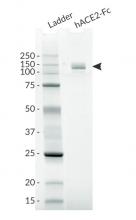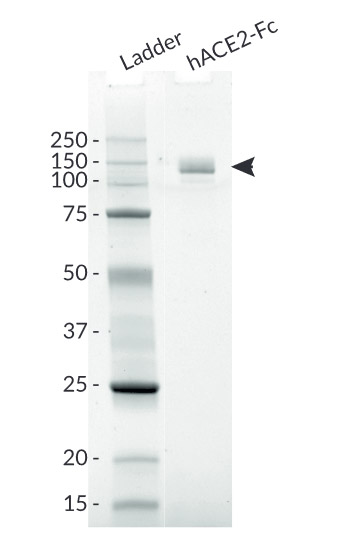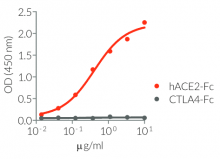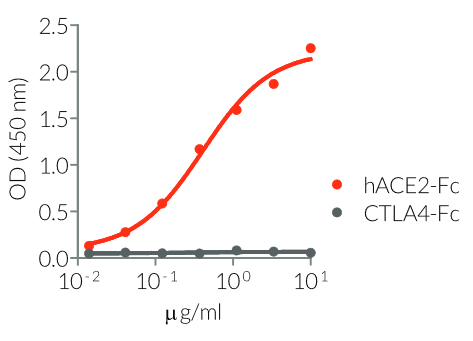Human ACE2 Protein
| Product | Unit size | Cat. code | Docs. | Qty. | Price | |
|---|---|---|---|---|---|---|
|
hACE2-Fc Soluble ACE2-Fc fusion protein |
Show product |
50 µg |
fc-hace2
|
|
SARS-CoV-2 cellular receptor: ACE2 with C-term Fc tag
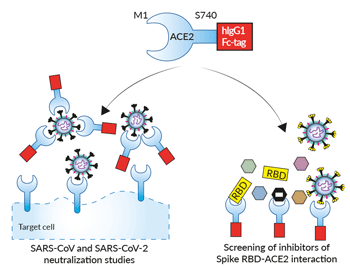
Potential applications of human ACE2 proteins
 InvivoGen also offers:
InvivoGen also offers:
• Soluble SARS-CoV-2 Spike proteins
• Soluble SARS-CoV-2 Nucleocapsid proteins
Protein description
Human ACE2 (angiotensin I-converting enzyme-2) is a Type I surface transmembrane protein expressed in arteries, heart, kidneys, and epithelia of the lung and small intestine [1, 2]. ACE2 belongs to the angiotensin-converting enzyme family of dipeptidyl carboxydipeptidases [2, 3].
ACE2 also plays a critical role in the human pathogenesis of the coronavirus disease-19 (COVID-19) caused by the severe acute respiratory syndrome coronavirus-2 (SARS-CoV-2, or 2019-nCoV). Indeed, hACE2 is now established as the receptor for the Spike (S) protein of the SARS-CoV and SARS-CoV-2 coronaviruses, facilitating the viral entry into target cells [4-6]. The blockade of the ACE2 receptor and the delivery of an excessive soluble form of ACE2 are among the investigated strategies to treat COVID-19.
The soluble hACE2-Fc protein was generated by fusing the C-terminus of the human ACE2 extracellular domain [M1-S740] to a human IgG1 Fc region.
This protein has been produced in CHO cells and purified by protein G affinity chromatography (See Details and Specifications for more information).
Applications
- SARS-CoV and SARS-CoV-2 neutralization assays
- Screening of small molecules inhibitors or of neutralizing antibodies able to block Spike-RBD and ACE2 interaction
Quality control
- Size and purity confirmed by SDS PAGE
- Protein validated by ELISA upon incubation with a coated Spike-RBD-His protein and an Anti-human IgG1-HRP detection antibody
![]() Learn more about SARS-CoV-2 infection cycle, immune responses, and potential therapeutics.
Learn more about SARS-CoV-2 infection cycle, immune responses, and potential therapeutics.
References
1. Harmer D. et al., 2002. Quantitative mRNA expression profiling of ACE2, a novel homolog of angiotensin-converting enzyme. FEBS Letters. 532(1-2):107-110.
2. Hamming I. et al., 2004. Tissue distribution of ACE2 protein, the functional receptor for SARS coronavirus. J. Pathol. 203:631-637.
3. Donoghue M. et al., 2000. A novel angiotensin-converting enzyme-related carboxypeptidase (ACE2) converts angiotensin I to angiotensin 1-9. Cir. Research. 87(5):e1-e9.
4. Li W. et al., 2003. Angiotensin-converting enzyme 2 is a functional receptor for the SARS coronavirus. Nature. 426(6965):450-454.
5. Hoffmann M. et al., 2020. SARS-CoV-2 cell entry depends on ACE2 and TMPRSS2 and is blocked by a clinically proven protease inhibitor. Cell. 181:1-16.
6. Zhou P. et al., 2020. A pneumonia outbreak associated with a new coronavirus of probable bat origin. Nature. 579(7798):270-273.
Specifications
- Protein construction: human ACE2 extracellular domain [M1-S740] with a C-terminal human IgG1 Fc tag
- Accession sequence: AAQ89076
- Species: Human
- Tag: C-terminal human IgG1 Fc
- Total protein size: 967 a.a. (secreted form)
- Molecular weight: ~130 KDa (SDS PAGE)
- Purification: Protein A affinity chromatography
- Purity: >95% (SDS PAGE)
-
Quality control:
- The protein has been validated by ELISA upon incubation with a coated Spike-RBD-His protein and an Anti-human IgG1-HRP detection antibody
- The absence of bacterial contamination (e.g. lipoproteins and endotoxins) has been confirmed using HEK-Blue™ TLR2 and HEK-Blue™ TLR4 cellular assays.
Contents
- 50 μg of lyophilized protein
- 1.5 ml of endotoxin-free water
![]() The product is shipped at room temperature.
The product is shipped at room temperature.
![]() Lyophilized protein should be stored at -20 ̊C.
Lyophilized protein should be stored at -20 ̊C.
![]() Resuspended protein is stable for up to 1 month when stored at 4°C, and 1 year when stored at -20°C
Resuspended protein is stable for up to 1 month when stored at 4°C, and 1 year when stored at -20°C
Avoid repeated freeze-thaw cycles.
Back to the topDetails
ACE2 is a metalloproteinase that cleaves angiotensin I to angiotensin 1-9 and angiotensin II to form angiotensin 1-7, as well as other peptides unrelated to the angiotensin system [1, 2]. ACE2 is thought to be an essential regulator of cardiac function and blood pressure [1].
Human ACE2 has also been described as a receptor for the Spike (S) protein of the SARS-CoV and SARS-CoV-2 coronaviruses, facilitating the viral entry into target cells [3-6]. SARS-CoV and SARS-CoV-2 share most of the amino acid residues essential for ACE2 binding within their Spike receptor-binding domain (RBD) [5]. Of note, SARS-CoV-2 is able to use human, Chinese horseshoe bat, civet, and pig ACE2, but not murine ACE2, to enter cells [6].
SARS-CoV-2 entry into ACE2-expressing cells also depends on the concerted action of host proteases. While the exact timing and location for these processes to take place remain to be determined, it has been proposed that the S protein is cleaved into two subunits (S1 and S2) by proteases, including furin and TMPRSS2 [5, 7]. S1 binds to ACE2 and S2 is further cleaved and activated by the host surface-associated transmembrane protease serine 2 (TMPRSS2) [5, 7]. Together these actions result in host-viral membrane fusion and the viral RNA genome is released into the host cell cytoplasm.
Human ACE2 is currently investigated among therapeutic strategies to fight SARS-CoV and SARS-CoV-2 infections [8-10].
References
1. Donoghue M. et al., 2000. A novel angiotensin-converting enzyme-related carboxypeptidase (ACE2) converts angiotensin I to angiotensin 1-9. Cir. Research. 87(5):e1-e9.
2. Harmer D. et al., 2002. Quantitative mRNA expression profiling of ACE2, a novel homolog of angiotensin-converting enzyme. FEBS Letters. 532(1-2):107-110.
3. Hamming I. et al., 2004. Tissue distribution of ACE2 protein, the functional receptor for SARS coronavirus. J. Pathol. 203:631-637.
4. Li W. et al., 2003. Angiotensin-converting enzyme 2 is a functional receptor for the SARS coronavirus. Nature. 426(6965):450-454.
5. Hoffmann M. et al., 2020. SARS-CoV-2 cell entry depends on ACE2 and TMPRSS2 and is blocked by a clinically proven protease inhibitor. Cell. 181:1-16.
6. Zhou P. et al., 2020. A pneumonia outbreak associated with a new coronavirus of probable bat origin. Nature. 579(7798):270-273.
7. Walls A.C. et al., 2020. Structure, function, and antigenicity of the SARS-CoV-2 spike glycoprotein. Cell. 181(2):281-292.e6.
8. Zhang H. et al., 2020. Angiotensin-converting enzyme 2 (ACE2) as a SARS-CoV-2 receptor: molecular mechanisms and potential therapeutic target. Intensive Care Medicine. 46(4):586-590.
9. Monteil V. et al., 2020. Inhibition of SARS-CoV-2 infections in engineered human tissues using clinical-grade soluble human ACE2. Cell. 181:1-9.
10. Lei C. et al., 2020. Neutralization of SARS-CoV-2 spike pseudotyped virus by recombinant ACE2-Ig. Nat. Comm. 11(1):2070.





